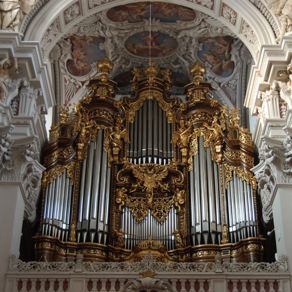 This is part three of a four-part series by Karen Elowitt, who recently took a cruise on the Danube River, sailing between Budapest, Hungary, and Passau, Germany with Uniworld Cruises.
This is part three of a four-part series by Karen Elowitt, who recently took a cruise on the Danube River, sailing between Budapest, Hungary, and Passau, Germany with Uniworld Cruises.
While battling the frigid temperatures of Eastern Europe in winter, she realized that small touches can make a big difference in the cruising experience, and narrowly avoided tourist burnout by discovering some unexpected surprises.
Over breakfast in the ship’s restaurant on Saturday, our tour director sheepishly informed us that it would in fact be the coldest day of the year so far in Austria.
He might have even said that it was going to be the coldest day in many years, but I can’t quite recall. Yes, we would have the pleasure of touring Mozart’s birthplace in 23-degree weather. Just to be clear, that’s 23 degrees Fahrenheit. I couldn’t think of any time I’d ever been in weather so cold, except maybe once in the mountains of Poland during a snowstorm. So I piled on some extra socks and scarves and braced myself.
Don’t miss Part 1 of Karen’s Danube River adventure in Budapest & Bratislava.
The ship was actually docked in Linz, a small artsy town about 60 miles from Salzburg, which meant quite a long bus ride to get to our destination. During the one-and-a-half hour trip, our amusing guide Helmut gave us some background on the city we were about to tour, which basically amounted to three things: Mozart, Mozart and Mozart.
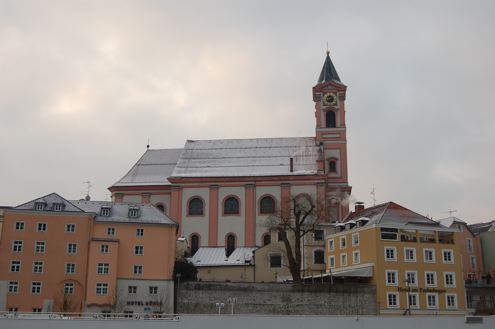 The city’s most famous son is so revered in town that it’s easy to forget that the composer actually left Salzburg as soon as he was able to, and chose to live in Vienna. Apparently he felt hemmed in by the old-fashioned provincialism of Salzburg and preferred the more stylish and free-wheeling capital of Austria.
The city’s most famous son is so revered in town that it’s easy to forget that the composer actually left Salzburg as soon as he was able to, and chose to live in Vienna. Apparently he felt hemmed in by the old-fashioned provincialism of Salzburg and preferred the more stylish and free-wheeling capital of Austria.
Nevertheless, Salzburg has duly preserved the maestro’s birth house and his adult residence, and has even created a confection just for him. The unfortunately-named but delicious “Mozart balls” (Mozartkugeln) consist of a marzipan center wrapped in nougat and dipped in chocolate.
But it’s not entirely true that Salzburg is all about Mozart. There’s the Mirabell palace and gardens, built by a long-ago bishop for his mistress, with whom he had a long-term love affair and about 15 children. Parts of the famous “Do Re Mi” sequence from The Sound of Music were filmed there (presumably not in winter, though).
 There’s also Salzburg Cathedral, with its elaborate Italianate Baroque interior, the nearby St. Peter’s church and cemetery, Hohensalzburg Castle, and the fashionable shopping street Getreidegasse to name a few. The entire old town area was designated a UNESCO world heritage site in 1997, and rightly so. It was quite impressive, even if it was covered by several inches of snow.
There’s also Salzburg Cathedral, with its elaborate Italianate Baroque interior, the nearby St. Peter’s church and cemetery, Hohensalzburg Castle, and the fashionable shopping street Getreidegasse to name a few. The entire old town area was designated a UNESCO world heritage site in 1997, and rightly so. It was quite impressive, even if it was covered by several inches of snow.
Though I spent the morning touring the town, by afternoon my fingers and toes were numb and I’d had enough. I called up an old friend who has lived in Salzburg for several years and got the inside scoop on the city over hot tea and some very un-Austrian lasagna.
It’s easy to combine Austria’s top cities in one tour. Check out the Off the Brochure Travel Guide: Vienna, Austria.
Though the tourists may have Mozart-mania, apparently the locals are not that enthused about the man. My friend told me how a taxi driver once described his “Mozart allergy,” which produced red welts on his skin every time the composer’s name was mentioned.
Salzburg is also a wealthy town. When they’re not buying and selling expensive real estate or helming large corporations, well-to-do members of the bussy-bussy gesellschaft (“kissy-kissy” society) socialize together, play golf at the same clubs, donate to the same charities, and spend their winters in warm places like Italy and Spain.
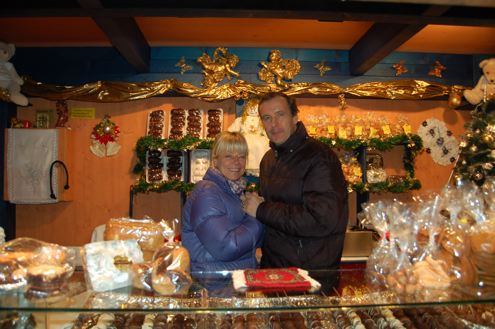 The afternoon flew by as we chatted, and before I could say “danke schön” I was back on the bus for the journey to Linz, then back on the boat. The ship’s staff greeted us with hot chocolate and hot towels, for which I was incredibly grateful.
The afternoon flew by as we chatted, and before I could say “danke schön” I was back on the bus for the journey to Linz, then back on the boat. The ship’s staff greeted us with hot chocolate and hot towels, for which I was incredibly grateful.
Now, I don’t know firsthand if other river cruise lines have the same level of service, but I really have to give kudos to Uniworld for those “extra special” touches. In addition to the hot towels and hot drinks every day after excursions, each guest also gets a daily news digest customized to his or her country of origin, twice-daily housekeeping service, and daily “port talks” which give historical context and logistical advice for the following day’s trip.
Though Europe has top billing on the marquee, in many ways the ship and its staff are really the stars of the show. From the dock the River Beatrice looks deceptively simple, but it packs a lot into its compact frame. And it hold only a maximum of 160 guests, which means that cruisers have more intimate experience than on those super-ships that cruise the seas.
Passau
 Just when I thought it couldn’t possibly get any colder, it did.
Just when I thought it couldn’t possibly get any colder, it did.
It was somehow fitting that the last day of the cruise was also the coldest day of the year. Over breakfast Tony told us to brace ourselves for a 15-degree day. As we waited on the banks of the Danube for the tour guides to arrive, my toes turned numb within a matter of minutes, even while wearing two pairs of socks.
Unfortunately, the tour guides were inexplicably delayed, so rather than risk hypothermia most of us opted to wait in the nearby Café Simon. The Simon family has been making gingerbread and other confections in Passau for at least four generations, so the café is THE place to go in town for a hot drink and a pastry. And considering that it was the only restaurant open at 10 a.m. on a Sunday, we didn’t have much choice.
The medieval town of Passau, in southern Bavaria, was the only German stop on our cruise. But as with all the other towns we’d visited, it featured—you guessed it—a Baroque cathedral, a castle on a hill, and narrow, picturesque cobblestone streets.
 In spite of this— or perhaps because of this— quite a few of my fellow cruisers had reached a certain level of tourist burnout and opted to skip the tour.
In spite of this— or perhaps because of this— quite a few of my fellow cruisers had reached a certain level of tourist burnout and opted to skip the tour.
Apparently the Australians have an acronym for this: ABC, which stands for Another Bloody Church.
Passau actually has a whopping 17 churches, which when compared to the population of 50,000, means that there is one church for every 3,000 people. Though Passauers are not a particularly religious bunch nowadays, back in medieval times it was quite a devout town. Since we arrived on a Sunday, church bells were ringing all over town as services began and ended, adding a nice aural dimension to our experience.
I personally never get tired of looking at churches and cathedrals, especially when they are as spectacular as the main cathedral in Passau. Aside from its dramatic height, vivid oil paintings, and towering tinted (not stained) glass windows, St. Stephan’s boasts a massive organ with 17,774 pipes. The organ is the third-largest in the world, and the largest one in a cathedral.
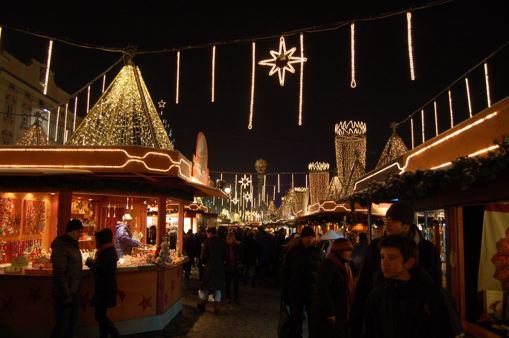 And I never get tired of Christmas markets, either. Call me a Luddite, but I think there is something special about being able to pick out unique handmade Christmas gifts from the person who actually made them—rather than impersonally ordering them online or from a big-box store like Costco.
And I never get tired of Christmas markets, either. Call me a Luddite, but I think there is something special about being able to pick out unique handmade Christmas gifts from the person who actually made them—rather than impersonally ordering them online or from a big-box store like Costco.
The tradition of the Christmas market began in medieval times in Europe, when the market square in the center of town was pretty much the only place to buy all your household goods. Though at most other times of the year the stalls were reserved for the professional merchants and traders, at Christmas they were often opened up to ordinary burghers seeking to make a few extra marks (or francs, or lire) by selling their own homemade wares.
After browsing Passau’s market and picking up a few gifts for friends and family, I panicked and wondered how I would fit all the additional stuff in my suitcase. It was already bursting at the seams when I left home, and I had stupidly forgotten to pack an extra bag. Since all the stores were closed on Sunday, there was no way I could buy a second bag or ship my purchases home via mail.
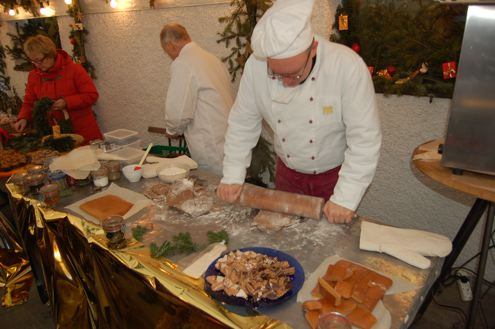 So I just chose to ignore the problem, and moved on to the gingerbread-making demonstration.
So I just chose to ignore the problem, and moved on to the gingerbread-making demonstration.
The bakers at Simon set up a demo table outside the back of their shop and braved the cold to show us the centuries-old techniques of mixing, cutting and baking gingerbread dough. The earliest recipes were fairly simple and non-perishable, and included only flour, honey and some spices. Now they can include brown sugar, butter, molasses and any number of other add-ins, but gingerbread essentially a simple, no-nonsense confection that has lasted through the centuries.
Want to get better at cooking? Visit our Cooking Classes section.
During the afternoon, while the boat was being moved from one dock to another, I toured the Glass Museum and the Modern Art museum, mostly in order to stay out of the cold. Even though I didn’t expect much out of it, I was pleasantly surprised to find that the glass museum really captured my interest.
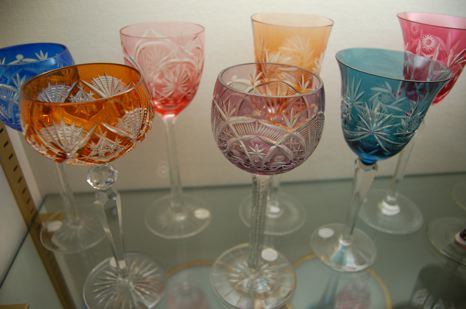 Featuring more than 30,000 pieces, the museum essentially chronicles the last 200 years of European history through glass. From dinnerware used by Emperors and Kaisers to Victorian mirrors and Art Deco paperweights, the four display floors also provide a little window (pun intended) into the art of glass and glassmaking in southern Germany.
Featuring more than 30,000 pieces, the museum essentially chronicles the last 200 years of European history through glass. From dinnerware used by Emperors and Kaisers to Victorian mirrors and Art Deco paperweights, the four display floors also provide a little window (pun intended) into the art of glass and glassmaking in southern Germany.
During the farewell dinner Sunday evening, which featured the requisite Baked Alaska (someday I’m going to find out how that peculiar cruise ship tradition got started), I felt alternately sad and relieved that my cruise was about to come to an end.
For seven days I’d lived in a dreamlike state of suspended reality, with fairy-tale European castles right outside my stateroom window, and magical Christmas markets beckoning me to explore them. I’d made some great friends on board, and gotten accustomed to the classy surroundings and attentive staff in my floating hotel.
But the relentless cold weather was starting to wear me out, and getting up every morning at the crack of dawn to go sightseeing was beginning to feel a little like a chore, as opposed to a vacation.
So I bade a bittersweet farewell to Europe and the elegant River Beatrice and headed back into the real world, with a carry-on full of gingerbread squares, Christmas tree decorations and a spare tire around my midsection to remind me of my excellent Danube River adventure.
By Karen Elowitt for PeterGreenberg.com.
Previously:
- Cruising the Danube River, Part 1: Budapest & Bratislava
- Cruising the Danube River, Part 2: Vienna & Krems
Related articles:












